PART 5 ? Battalion Organisational Structure 1965 - 1972
Each Battalion organisation consisted as follows (this applies to the era 1965 - 1972
Battalion
HQ Group
(5 Officers and 31 Other Ranks), 4 x Rifle
Companies (Alpha, Bravo, Charlie and Delta)
(each of 5 Officers and 118 Other Ranks)
Each company consisted of,
Company HQ - 2 Officers and 13 Other Ranks
Support Section - 6 Other Ranks
3 x Platoons each of
Platoon HQ, 1 Officer and 3 Other Ranks (Platoon Sergeant, radio operator and batman)
3 x Rifle Sections each of 10 Other Ranks (1 Corporal, 1 Lance Corporal, 8 Privates)
Support Company
Support Company HQ - 1 Officer and 12 Other Ranks
Mortar
Platoon - 2 Officers and 39 Other Ranks
(HQ
- 2 Offr and 6 Other Ranks) (3 Sections of 11 personnel)
Platoon HQ consisted of a CAPT (Pl Comd), LT (2IC) and 2 CPL's a driver/batman, an admin element of the Pl SGT and storeman and driver/batman.
Each section consisted of 2 detachments of 4 mortar numbers with one trained as a driver and a HQ element of a Sect Comd (SGT), 2IC (CPL) and CPO Assistant (PTE). Best Replica Watches
Each Pl had a GPMG at Pl HQ and were armed with 11 pistols, 16 SMG's and 14 rifles
Their tasks were to provide mortar support for the Battalion and the Task Force with six 81mm mortar tubes and generally operated from a static location within the Task Force Group area and from Fire Support Bases (FSB), or mobile - from APC's converted to Mortar Carriers. A Mortar Fire Controller (MFC) would accompany rifle companies in the field.
Anti-Tank Platoon - 1 Officers and 31 Other Ranks
Equipped with 16 Medium Anti-Tank Weapons (MAW) the Platoon provided additional fire support for the battalion.
Signals Platoon - 1 Officer and 39 Other Ranks
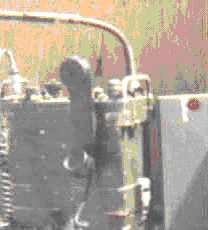
Equipped with the ANPRC 25 radio set provided and maintained all radio and telephone communication requirements for the battalion. Each rifle company HQ was allocated two radio operators. Radio Operators manned the radios and telephones in the battalion Command Post (CP) and accompanied the battalion on operations.
Platoon radio operators were normally drawn from the platoon itself.
Assault Pioneer Platoon - 1 Officer and 31 Other Ranks
Played a similar role to engineers. This Platoon provided valuable support for the battalion in defence works, mine detection and field engineering
Surveillance Platoon - 1 Officer and 14 Other Ranks
Administration Company
Headquarters - 1 Officer and 6 Other Ranks
Quartermaster Platoon - 3 Officers and 42 Other Ranks
Medical Platoon - 1 Officer and 38 Other Ranks
Administration Company provided ammunition, stores, motor vehicles, cooks and medical staff. Admin Coy was tasked to provide everything required for the battalion to operate, at base and on operations.
Total Strength = 37 Officers and 755 Other Ranks
It is unlikely that any battalion ever went into the field at full strength. Illness, leave entitlements, troops ending period of engagement all sapped a battalions strength. The numbers above are a guide only and were altered to suit circumstances on a daily, weekly and tour basis.
The Infantry Rifle Section
Composition - 1 Corporal (Section Commander) - 1 Lance Corporal (Section 2nd In Command) - Scout Group (2 Privates) - Gun Group (2 Privates) - Rifle Group (4 Privates).
Weapons Used by Infantry Rifle Sections
![]() L1A1
Self Loading Rifle (SLR) - semi auto - fired a
7.62mm standard NATO round - weight 10lbs - magazine capacity 20 rounds - range
300metres - standard issue weapon for all soldiers in the Australian Army. Very
robust and dependable weapon. Each soldier carried at least 150 rounds each.
L1A1
Self Loading Rifle (SLR) - semi auto - fired a
7.62mm standard NATO round - weight 10lbs - magazine capacity 20 rounds - range
300metres - standard issue weapon for all soldiers in the Australian Army. Very
robust and dependable weapon. Each soldier carried at least 150 rounds each.
M16A1
Armalite Rifle - (Colt AR15)
fully auto - 5.56mm round - weight 7 lbs. - magazine capacity 20/30 rounds -
range 300 metres - carried primarily by forwards scouts in each section of a rifle
company, also issued to selected appointments in a unit. This weapon was not
issued to Australian troops until stocks were obtained form US sources in 1966.
Early versions of this weapon were prone to stoppages and breakages, caused
mainly by an unsatisfactory and weak alloy bolt carrier. That was fixed
300 metres - carried primarily by forwards scouts in each section of a rifle
company, also issued to selected appointments in a unit. This weapon was not
issued to Australian troops until stocks were obtained form US sources in 1966.
Early versions of this weapon were prone to stoppages and breakages, caused
mainly by an unsatisfactory and weak alloy bolt carrier. That was fixed
General
Purpose Machine Gun M60 (GPMG M60) - fired a
7.62mm round and fed by linked ammo belt of 100 rounds
 - weight 23 lb - range up to 1100
metres. This was the main fire support weapon for each section that carried 1
M60 and at least 1200 rounds. Reliable weapon, provided ammunition belts were
kept clean and the weapon was well maintained. Was prone to continual stoppages
if the weapon became too worn. One hundred rounds of ammunition weighed seven
(7) pounds.
- weight 23 lb - range up to 1100
metres. This was the main fire support weapon for each section that carried 1
M60 and at least 1200 rounds. Reliable weapon, provided ammunition belts were
kept clean and the weapon was well maintained. Was prone to continual stoppages
if the weapon became too worn. One hundred rounds of ammunition weighed seven
(7) pounds.
F1 Sub
Machine Gun
- fired a 9mm round - magazine capacity 30 rounds - weight 7.2 lb - range 100
metres. This weapon was totally
unsuitable for conditions in Vietnam. The range (100 Metres) and low velocity of
the 9mm round was not capable of penetrating the jungle and undergrowth. The M16
Armalite was eventually issued in place of this weapon.
was totally
unsuitable for conditions in Vietnam. The range (100 Metres) and low velocity of
the 9mm round was not capable of penetrating the jungle and undergrowth. The M16
Armalite was eventually issued in place of this weapon.
M79 40mm
Grenade Launcher - carried by each rifle section
with 36 rounds - weight 6 lb - range 300 metres.

Very effective against enemy troops and light installations.
M26
Fragmentation Grenade - carried by each member of
a rifle section - lethal radius of 10 metres. Used effectively
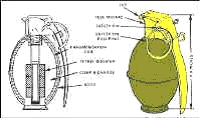 for close quarter fighting and
clearing enemy bunkers and weapon pits.
for close quarter fighting and
clearing enemy bunkers and weapon pits.
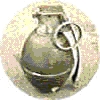 A smooth bodied high explosive
grenade. It weighed 425g with a fuse delay of five seconds. The average throwing
distance was 40 metres. Its blast radius was ten metres, with a killing distance
of 5 metres and a wounding distance of up to 25 metres. The members were
initially issued with two M26 grenades per man.
A smooth bodied high explosive
grenade. It weighed 425g with a fuse delay of five seconds. The average throwing
distance was 40 metres. Its blast radius was ten metres, with a killing distance
of 5 metres and a wounding distance of up to 25 metres. The members were
initially issued with two M26 grenades per man.
No 83 Smoke Grenades - used in various colours to indicate to position of enemy and friendly troops. Used largely to indicate to helicopters and aircraft, the position of a unit. Helicopters would not land or evacuate wounded until a smoke grenade was thrown and the colour of the grenade was verified.
M49 Trip Flare - and used at night as an early warning device to detect and illuminate enemy movement.
M18A1
Claymore Mine - 10 carried by each rifle section -
range of 50 metres. Used extensively as a defensive weapon
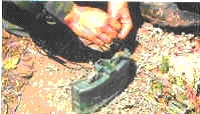 in night harbours and was most
effective when used in ambushing enemy parties.
in night harbours and was most
effective when used in ambushing enemy parties.
M72 66 mm
Light Anti-Tank Weapon (LAW) - weight 4.5 lbs. -
range 200 metres. Light weight and simple design, this
 weapon was most effective against
enemy installations such as bunkers and buildings. Fired a high explosive round
from a disposable launcher.
weapon was most effective against
enemy installations such as bunkers and buildings. Fired a high explosive round
from a disposable launcher.
A Typical Load carried by an Infantry Soldier.
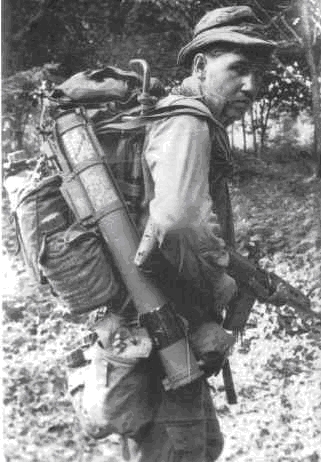 Individual items of gear included,
basic webbing harness, weapon and ammunition, a shell dressing, entrenching
tool, machete, M26 grenade, nine full water bottles, five days rations, small
stove and hexamine tablets for cooking, shaving gear, steel mug, shelter,
lightweight blanket, hammock, spare socks and bayonet.
Individual items of gear included,
basic webbing harness, weapon and ammunition, a shell dressing, entrenching
tool, machete, M26 grenade, nine full water bottles, five days rations, small
stove and hexamine tablets for cooking, shaving gear, steel mug, shelter,
lightweight blanket, hammock, spare socks and bayonet.
In addition each 10 man section shared a load of, 6 x 100 round belts for the M60 MG, spare barrel for the M60 MG, M49 flares, smoke grenades, white phosphorus grenades, grenade spigots and ballastite cartridges, claymore mines, detonating cord, plastic explosive, M79 rounds, M72 LAWs, spare radio batteries, torch, starlight scope night vision device, panel markers for identification to aircraft, binoculars, compass, maps, protractor, pace counter, strobe light, secateurs, medical kit, watches, codes and writing equipment.
Signallers carried the ANPRC Radio with spares batteries and handset and antennas.
Platoon medics carried a comprehensive medical kit.
Dress - consisted of jungle greens with sleeves down, general purpose boots (GPs), sweat rag, floppy green bush hat.
The Battalion returned home to Australia to Enoggera in May 1969, as part of 6 TF, 1 Div and later relocated to Townsville, as part of the 3 TF, 1 Div in December 1969.
Two good books of the Battalion?s first tour of Vietnam are Brian Avery?s ?In the Anzac Spirit? and Wayne Brown?s ?Medic?.